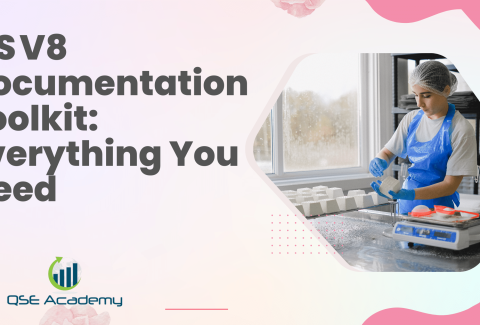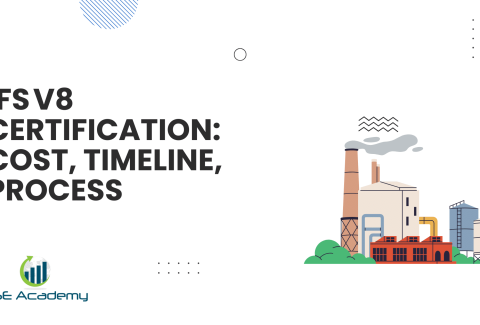Implementing IFS V8: 90‑Day Action Plan
Last Updated on November 19, 2025 by Melissa Lazaro
A Structured Timeline Makes Implementation Manageable
Many companies delay certification because the implementation process feels large, complicated, and time-consuming. The reality is that IFS V8 becomes far more achievable when you break it into clear steps with a focused timeline. A 90-day plan provides structure, momentum, and accountability. It transforms implementation from something overwhelming into something practical and measurable.
This guide walks through a phased approach where each milestone builds logically toward the next: preparation, documentation, rollout, verification, and audit readiness. With a clear weekly sequence and defined ownership, your team knows exactly what to focus on, when tasks must be completed, and how progress will be monitored.
By following this plan, you create a system that aligns with IFS V8 requirements and works in daily operations—not just during an audit.
Phase 1 — Days 1–30: Foundation, Scope & Gap-Analysis
The first month is dedicated to understanding where you currently stand and setting up the structure for the rest of the implementation. Without this phase, teams tend to jump into documentation or process changes without clarity, which leads to duplication, rework, and wasted time.
Key Activities:
- Define the certification scope and boundaries
- Identify applicable product groups and activities
- Assign responsibilities and establish the implementation team
- Conduct a clause-based gap-analysis using IFS V8 requirements
- Prioritize findings using risk and audit relevance
- Create the implementation timeline and communication plan
Practical guidance:
Color-coding the gap-analysis into high, medium, and low priority allows the team to stay focused on requirements that affect audit readiness rather than minor improvements.
Common barrier:
Teams sometimes assume previous certifications or versions automatically cover new requirements. Alignment, not assumption, ensures compliance.
 Phase 2 — Days 31–60: Documentation, Controls & Competency Framework
Phase 2 — Days 31–60: Documentation, Controls & Competency Framework
Once the priorities are clear, the next step is building or refining the documented foundation that supports implementation.
Core Deliverables:
- Updated Food-Safety and Quality Manual aligned with IFS V8
- Standardized templates for forms and records
- Clear and controlled procedures and SOPs
- Defined competency and training matrix by roles
- CCP/OPRP validation and evidence structure
- Document control and distribution system
Documentation should be accurate, usable, and aligned with real processes. Complex content may look impressive, but simplicity strengthens consistency.
Tip:
Standardizing templates early prevents inconsistencies during rollout and keeps training straightforward.
Typical challenge:
Creating too many documents. Focus on documents that demonstrate control, not unnecessary paperwork.
Phase 3 — Days 61–75: Operational Rollout & Change Deployment
Now the documented system transitions to real-world practice. This is where operational alignment takes priority.
Actions to implement:
- Train teams based on updated procedures and risk roles
- Deploy recordkeeping systems across departments
- Implement allergen controls, hygiene zoning, calibration routines, and operational prerequisites
- Begin live validation and verification activities
- Conduct cross-functional process checks
A short observation from experience: when rollout is phased by department rather than executed site-wide at once, adoption becomes easier and more sustainable. Smaller adjustments allow teams to internalize expectations instead of feeling overwhelmed.
Key reminder:
Consistency matters more than speed during rollout.
Phase 4 — Days 76–90: Verification, Internal Audit & Audit Readiness
With the system in use, the final stage focuses on ensuring everything functions reliably and aligns with IFS V8 expectations.
Critical tasks:
- Conduct a full internal audit aligned to IFS V8 clauses
- Correct and document nonconformities
- Complete management review with risk inputs, improvements, and trend analysis
- Confirm verification records and evidence traceability
- Prepare logistics, interview readiness, and documentation indexing for the audit
A structured internal audit acts as the rehearsal before certification. It validates the system and gives the team time to refine processes, strengthen weak areas, and finalize documentation.
Avoidable issue:
Leaving internal audits until the final week. Schedule them early enough to address findings.
Monitoring Progress — Tools and Methods That Keep Momentum Strong
Even the best plan loses impact if progress isn’t measured. Tracking tools help maintain alignment, visibility, and accountability throughout the implementation.
Useful components include:
- Project tracker or dashboard
- Document register with revision status
- Training matrix with completion status
- CCP/OPRP validation and monitoring log
- Corrective-action register linked to internal auditing
Whether using spreadsheets or simple digital project tools, the key is consistency and accessibility for all responsible team members.
FAQs — Addressing Common Implementation Questions
Q1: Is a 90-day implementation realistic for every site?
It’s achievable for many operations, especially those with an existing food-safety foundation. High-complexity sites may extend certain activities without losing momentum.
Q2: When should the certification body be selected?
Ideally early in the process, especially if your preferred audit window has availability constraints.
Q3: How much external support is needed?
Most teams can manage implementation internally. External support is most valuable for gap-analysis review, validation assistance, or internal audit coaching.
Conclusion — A 90-Day Plan Builds Clarity, Confidence, and Control
A structured timeline transforms IFS V8 implementation from a large concept into a series of clear, achievable steps. By approaching certification in phases—plan, build, deploy, verify—you reduce uncertainty and build a system that’s functional, controlled, and aligned with operational reality.
With the core framework established, your next step is assigning ownership, scheduling milestones, and tracking progress.
Melissa Lavaro is a seasoned ISO consultant and an enthusiastic advocate for quality management standards. With a rich experience in conducting audits and providing consultancy services, Melissa specializes in helping organizations implement and adapt to ISO standards. Her passion for quality management is evident in her hands-on approach and deep understanding of the regulatory frameworks. Melissa’s expertise and energetic commitment make her a sought-after consultant, dedicated to elevating organizational compliance and performance through practical, insightful guidance.








